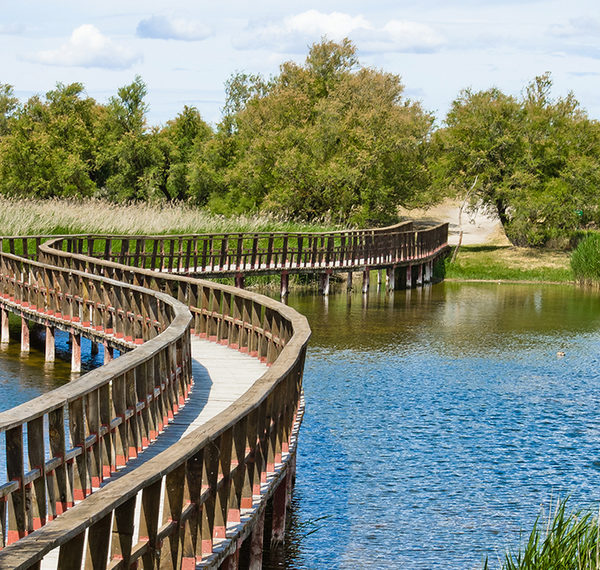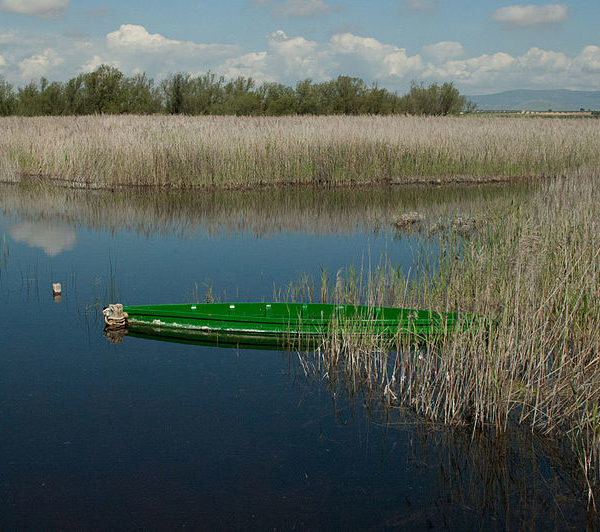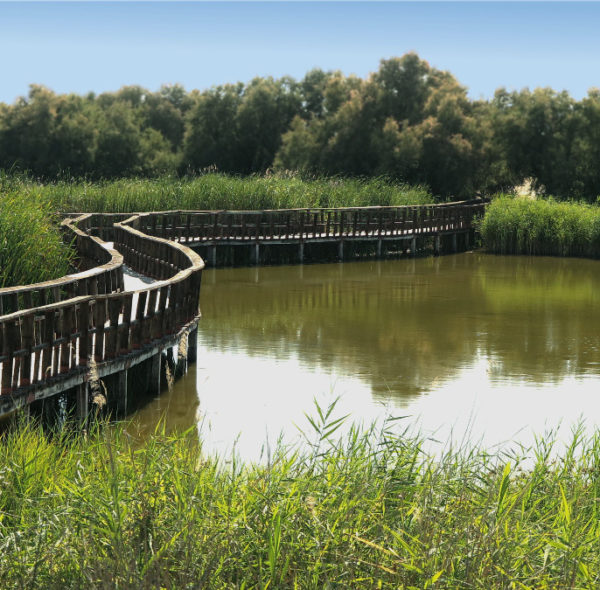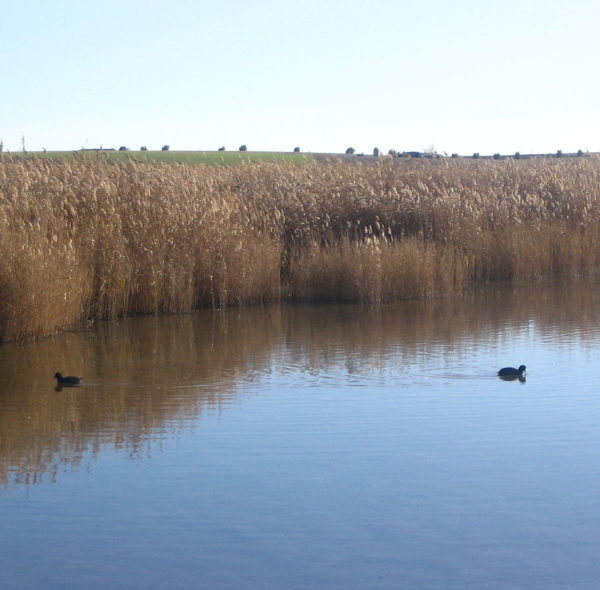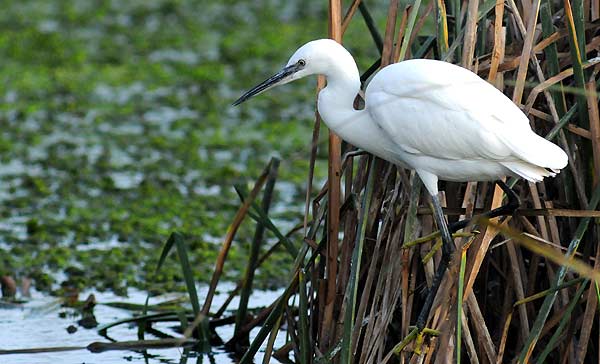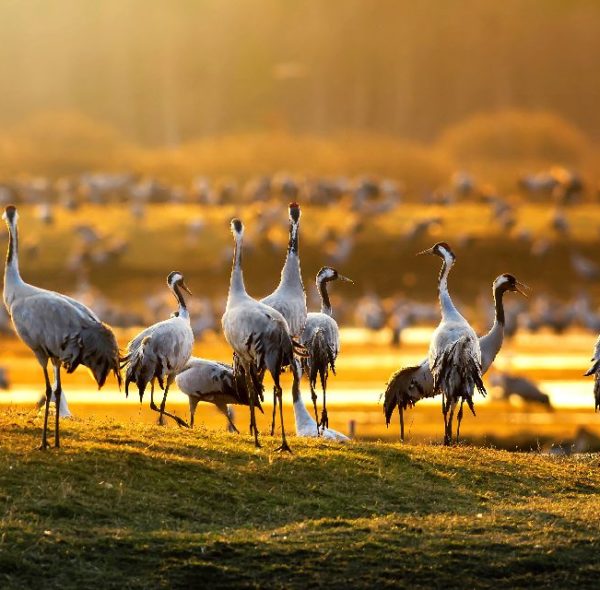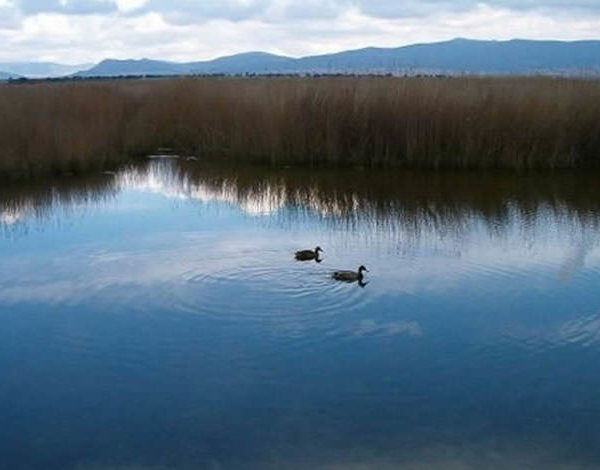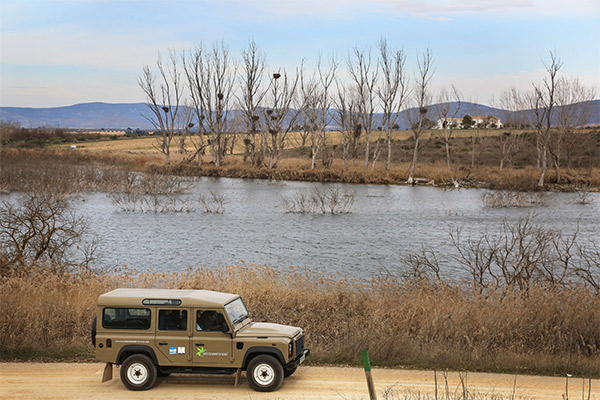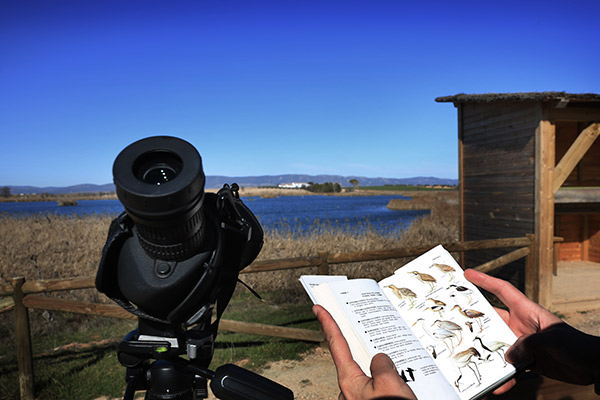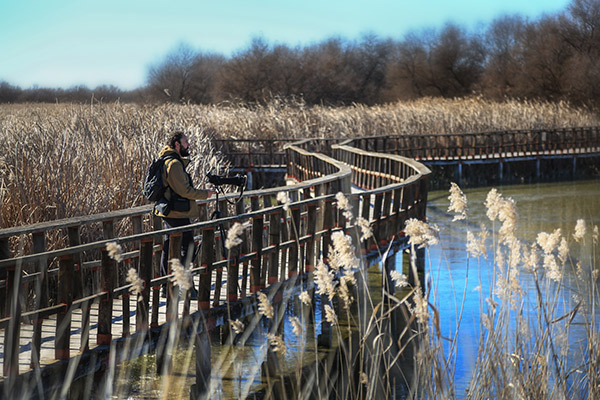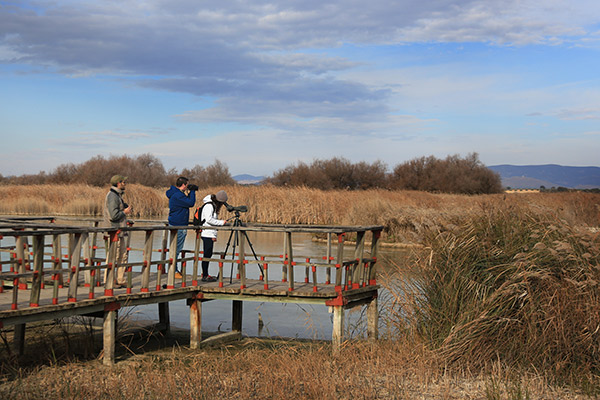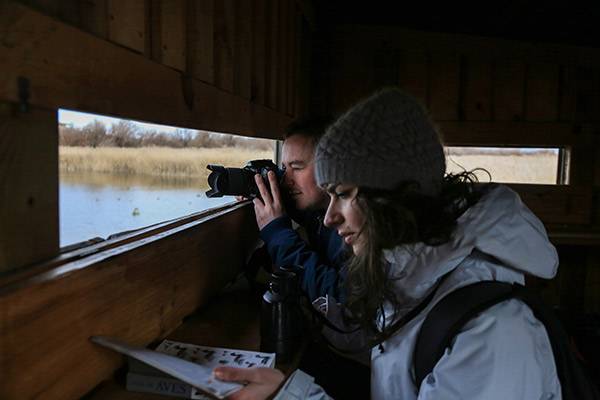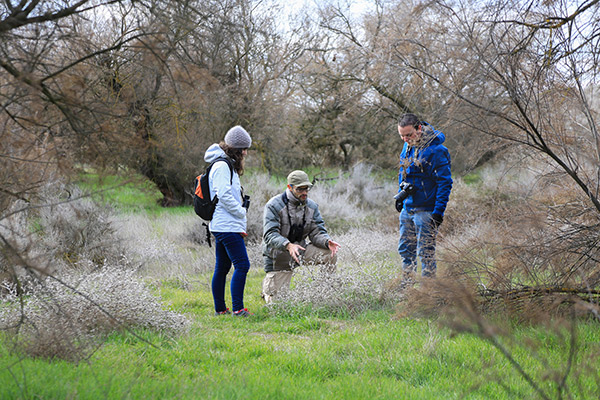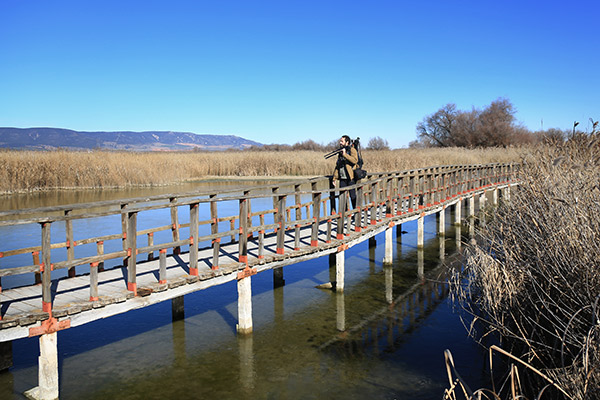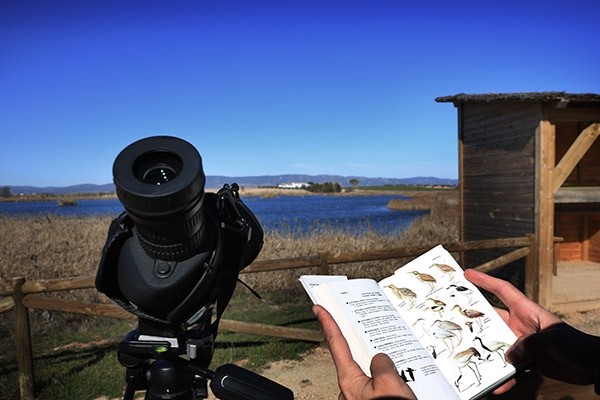The wetland known as Las Tablas de Daimiel was declared a National Park in the year 1973, Biosphere Reserve in 1981 and included in the Ramsar Convention in 1982.
It is the last representative of an ecosystem called river tables, this formation is produced by the overflowing of the Guadiana and Gigüela rivers, favoured by the lack of slope in the terrain.With its declaration as a National Park, a major step was taken towards the conservation of one of the most important most valuable ecosystems on our planet, this ensures the survival of the birds that use these areas as wintering, feeding and nesting grounds.
Other information of interest
Date of declaration: Decree 1874/73 of 28 June 1973.
Reclassification: Law 25/80 of 3 May.
Instruments: PRUG in the process of being drawn up.
Area: 3,030 hectares.
Province: Ciudad Real.
Autonomous Community: Castilla-La Mancha.
Supranational networks
Supranational networks:
- Biosphere Reserve (1981).
- Wetland of International Importance by the Ramsar Convention (1982).
- SPA (1988).
Documents:
Declaration: Decree 1874/73 of 28 June.
Reclassification: Law 25/80, of 3 May.
More information
Find out a little more information about the Park's surroundings.
Geology
The Tablas de Daimiel National Park is formed in the floodplain of two rivers of different natures, the Guadiana (fresh and permanent waters) and the Gigüela (salty and seasonal waters).
The Park is located almost in the transition zone of the western La Mancha Plain with the Campo de Calatrava, with a NE-SW direction at the foot of the Precambrian and Palaeozoic alignments of quartzite, sandstone and slate of the Montes de Toledo.
To the southeast of the La Mancha Plain is the Campo de Montiel, formed over horizontal stratigraphic series of dolomites, limestones and marls from the Lower Jurassic and limestones and sandstones from the Lower and Middle Cretaceous.
On the southernmost edge, Palaeozoic mountain ranges of quartzite and slate also emerge, which are very similar to the Montes de Toledo and geographically belong to the Sierra Morena.
The oldest materials are located to the south of Las Tablas, forming small isolated hills (heads 658 m). These hills are formed by metamorphic rocks (rocks that form from high temperatures and/or pressure, generating new compounds), such as quartzite or slate. They come from the Lower Ordovician.
In ascending order, the following materials correspond to the Tertiary and are located in the north of Las Tablas, resting on quartzite and slate from Los Montes de Toledo. They are formed by sands and muds. The sands are quartzite and the muds contain clays.
On small occasions, they are usually covered by alluvial materials. They correspond to the Upper Pliocene. However, it is important to point out that the dominant materials in Las Tablas are limestones and marls, also from the Upper Pliocene. These are covered by calcareous crusts and alluvial materials from the Quaternary. The limestones form dolines (circular depressions on the surface of a karstic terrain. They vary in size and originate from dissolution processes) and uvales. At the Pliocene-Pleistocene boundary, a series of crusts and limestone crusts appear.
The first group appears to the NW of the Park and covers sands and clayey muds from the Upper Pliocene in the Guadiana riverbed. The second group descends from NW to SE (they are embedded at about 15 or 20 m above the level of the Guadiana) and is formed by erosion surfaces covered by crusts. The Quaternary formations are superficial and in the form of terraces located on the right bank of the Guadiana (NW of Las Tablas); fluvial fans, colluvium, alluvial deposits filled with dolines and strings of dunes that were dragged to this area by the Azuer, Guadiana and Gigüela rivers.
Finally, it is important to highlight the palaeoclimatic formations, i.e. accumulations of sand of aeolian origin in the north-eastern part of the Park.
Text prepared by: Marí Cruces Moreno
Hydrology
"Daimiel is an oasis in the steppe of La Mancha (...) It is the miracle of water, it is the buried treasure brought to the surface by years, lustrums, perhaps centuries of work. Miracles of Daimiel, a marvel of transformation from dry land to irrigated land, which is repeated in other areas of La Mancha, although to a lesser extent, because the fertility of the steppe is conditioned by the existence of water". ( Francisco Pérez Fernández: Daimiel, Geografía de un pueblecito Manchego, Ciudad Real, Publicaciones del Instituto de Estudios Manchegos, 1958, p. 7).
The Tablas de Daimiel are formed by the confluence of two rivers of different natures, the Guadiana, of fresh water and permanent nature, and the Gigüela, of salty water and seasonal nature. Both rivers are situated in a gentle depression in the land and over limestone rock (which facilitates waterlogging), giving rise to a river lagoon flooded with groundwater from the discharge of the aquifer in the Llanura Manchega (La Mancha Plain).
Life in Las Tablas begins in a simple way: the Gigüela, a seasonal river, floods the plain during the winter, while the Guadiana, with a permanent character, provides water from the aquifer all year round, from the Ojos del Guadiana (groundwater outcrops of the Guadiana river). They are located about 12 km upstream from Las Tablas).
All this generates a flooded surface almost all year round, with very peculiar chemical characteristics. Las Tablas de Daimiel are located in the Upper Guadiana River Basin, which means that the Park is linked to its surface basin. The basin extends for some 13,000 km and the main hydrographic network is formed by the rivers Gigüela, Azuer, Záncara and Guadiana, all of them with very similar seasonal functioning. However, the Guadiana riverbed has become a recipient of water from the Park, causing subsidence and infiltrating from here to the aquifer.
Another important source of water for Las Tablas is the so-called Aquifer 23, which extends for some 5000 km. Las Tablas was the recipient of its water until the 1970s, when the region's developmental impulse transformed the traditional rainfed crops into irrigated crops. This transformation in the irrigation system has caused the Park's water levels to fall, so the flooded surface area has been decreasing and variable over the last few years.
The flooded surface area is around 1800 hectares. The general pattern used to be of peaks in spring, and lows without total desiccation in summer. At present, the tendency is usually to have a maximum in winter and a minimum without total desiccation in summer. The Water Regeneration Plan aims to achieve acceptable flood levels at the end of the dry season.
It should be noted that in recent years there has been an increase in the levels of eutrophy, as a consequence of an increase in nutrients. This has led to a massive production of algae and emerging higher plants, resulting in a greater accumulation of organic matter within the wetland, resulting in a higher percentage of liquid oxygen dissolved in the water, which helps to decompose the organic remains.
At present and since 2011, the Tablas de Daimiel National Park once again has a waterlogged surface area of between 50-80% thanks to the recovery of the levels of the aforementioned Aquifer 23.
Text prepared by: Mari Cruces Moreno
History
The most ancient settlers of whom there is archaeological evidence lived in Las Tablas approximately 3,500 years ago. This is the Bronze Age of La Mancha, a culture based on agriculture and livestock farming, whose settlements formed circular structures and which, due to the passage of time, have been covered by vegetation, forming mounds that are clearly visible in the surrounding area. This is the case of the "Motilla de Las Cañas", which is inside the National Park (currently surrounded by water), or others which are also found in the Guadiana but outside the limits of the Park, such as the "Motilla de La Máquina" or the "Zuacorta". We can also find the "Motilla del Azuer" on the course of the Azuer River, which is currently being explored and studied.
The "Motilla de Las Cañas" was inhabited again by the Iberians; later, we also know of the Roman civilisation, as can be seen in the remains of this culture found in the Park; and of the Visigoths, of whom we also have traces of their civilisation in archaeological remains that have been found in the surrounding area.
When we talk about Las Tablas we cannot fail to mention the "Dehesa de Zacatena", as the history of this is also the history of the Park. Although today it is reduced to the holm oaks that we can see in the background from the Isla del Pan if we look towards the sierra, the surface area of the pastureland was even larger than that of the Park today and constituted a single entity that was first administered by the Muslims and then by the Christians, both from the fortress of Calatrava la Vieja. This city, very close to Las Tablas, would have a great influence on the whole area during the Middle Ages and would be a Christian objective in its desire to dominate the defensive line of the Guadiana.
Once the area was pacified, it was granted to the Order of Calatrava, which took the name of this fortress and began to repopulate its domains. These religious knights would soon impose their power on the Dehesa de Zacatena and would administer it throughout the Middle Ages and a good part of the Modern Age. With the incorporation of the military orders into the Crown during the reign of the Catholic Monarchs, Las Tablas became part of the interests of the different Castilian monarchs. It is worth noting that the Dehesa de Zacatena must have been a real manorial reserve of the Master of the Order and later of the monarchs, from which important benefits were extracted from the exploitation of the rich pastures for livestock, from the capacity of the flour mills on the Guadiana or from the existing hunting and fishing, among many other uses.
The first description of its richness for hunting can be found in the "Libro de la Caza" of 1325, written by the Infante Don Juan Manuel and the "Relaciones Topográficas mandadas hechas por Felipe II", where we have the first news of the history of the preservation of the area, the result of the hunting interests of Felipe II. With the passing of time, the pastureland, which provided pasture for the Order's cavalry, lost this function and Zacatena became an excellent greenhouse for transhumant Merino sheep.
In contemporary times, the liberal confiscations distributed the lands of Las Tablas among wealthy landowners and this was the time of organised hunting, with the appearance of the first hunting societies that leased hunting in the area. Over the years, agriculture put pressure on the limits of Las Tablas and promoted a "developmentalism" that would eventually prove fatal for the Park. Not even the protection afforded by the declaration of the National Park in 1973 was able to halt the progressive deterioration suffered by Las Tablas due to the lack of water to this day, which seriously conditions the future of the area.
Text prepared by: Alberto Celis
Wildlife
Las Tablas is the wetland with the greatest faunal richness in the centre of the peninsula, which is why we present here a list of the most interesting species, either because of their abundance, their rarity or their role in the ecosystem. Logically, aquatic species are the most significant here.
BIRDS present throughout the year (residents):
Grebes, both the Little Grebe (Tachybaptus ruficollis) and the Great Crested Grebe (Podiceps cristatus) are expert divers in search of invertebrates and fish.
Of the Egrets, the secretive Little Bittern (Ixobrychus minutus) and the Cattle Egret (bubulcus ibis), present in all the nearby fields, are the only herons present all year round.
Ducks, the most characteristic waterfowl, have in the Azulon (anas plathyrhynchos) their most common and abundant representative. Much scarcer is the Fritillary Duck (anas strepera) named in the spot "Beato" due to the colour of its plumage.
Of the rails, the Common Coot (fulica atra) is the main representative, provided there are good water levels and submerged vegetation for feeding; the European Rail (Rallus aquaticus) is much easier to hear than to see. The Water Gallinule (Gallinula chloropus) is abundant and also common in all wet environments.
The most characteristic bird of the marsh vegetation and visible all year round is the Moustached Tit (Panurus biarmicus), although the Marsh Bunting (Emberiza schoeniclus) and the Bastard Nightingale (Cettia cetti) are also easy to spot.
The most representative bird of prey in Las Tablas is the Western Marsh Harrier (Circus aeruginosus) which, as a winged predator, occupies the highest position in the food chain of the wetland.
BIRDS present during Spring and Summer (Nesting):
The most emblematic duck on the boards is the Ruddy Duck (Netta rufina) which had its most important breeding area here and, together with the also diving European Pochard (Aythya ferina), breeds abundantly in years with good water levels.
The Purple Heron (Ardea purpurea) establishes its breeding colonies among the reeds and sandbanks. The rest of the herons: Little Egret (Egretta garzetta), Cattle Egret (Bubulcus ibis), Cattle Egret (Ardeola ralloides) together with the Night Heron (Nycticorax nycticorax) form arboreal colonies in the reed beds of Las Tablas.
The birds of the reedbeds are almost all distant migrants, such as the Aquatic Warbler (Acrocephalus scirpaceus), the Reed Warbler (Acrocephalus arundinaceus) and the Unicoloured Reed Warbler (Locustella luscinioides), which come to nest from the distant African wintering areas.
The spring migration or prenuptial migration is the best time to observe the group of birds known as waders, of which the Black-winged Stilt (Himantopus himantopus) and the Redshank (Tringa totanus) stay here to breed.
At the end of summer there are large concentrations of White Storks (Ciconia ciconia) and groups of Black Storks (Ciconia nigra) prior to their migration.
BIRDS present during autumn and winter (wintering):
From autumn onwards there is a change in the winged fauna of the Park; the waders that have already bred migrate and practically all the European wader species can be seen passing through: Black-tailed Godwits (Limosa limosa), Sandpipers, Plovers, Sandpipers, Sandpipers and the Lapwings (Vanellus vanellus) arrive and spend the whole winter here.
The Common Mallards (Anas acuta) pass by, and the Common Teals (Anas crecca) and Spoon-billed Ducks (Anas clypeata) announce the arrival of the cold weather. The whistles of the Whistling Mallards (Anas penelope) are heard on the coldest days of the year.
Grey Herons (Ardea cinerea) take over from Purple Herons (Ardea purpurea).
Flocks of Common Cranes (Grus grus) fly over the skies of Las Tablas at dawn and dusk, and groups of Great Cormorants (Phalacrocorax carbo) dive in groups to catch fish.
The Marsh Harrier (Circus aeruginosus) is now accompanied by its relative the Hen Harrier (Circus cyaneus) which uses the reed beds for hunting and roosting.
Birdwatching in Las Tablas is full of surprises; we may come across the rare Morito (Plegadis falcinellus), the very scarce Cerceta Pardilla (Marmaronetta angustirostris) or the fleeting passage of the Osprey (Pandion haliaetus).
MAMMALS
The other important group of fauna in the Tablas are the mammals, among which the wild boar (Sus scrofa) and the fox (Vulpes vulpes), rabbits (Oryctolagus cuniculus) and Iberian hares (Lepus granatensis) abound, with the otter (Lutra lutra) being the queen of the river due to its adaptation to aquatic environments. The Water Rat (Arvicola sapidus), Hedgehogs (Erinaceus europaeus) and other micromammals complete the list of species.
AMPHIBIANS AND REPTILES
Of the amphibians and reptiles, we highlight those that are especially adapted to water, such as the Common Frog (Rana perezi) and the San Antonio Frog (Hyla arborea), the Viper Snake (Natrix maura), the Collared Snake (Natrix natrix) and the European Wrassow (Emys orbicularis) and the Leper Snake (Mauremys leprosa). The Ladder Snake (Elaphe scalaris), the Bastard (Malpolon monspessulanus) and the Ocellated Lizard (Lacerta lepida) inhabit the islands.
FISH
The fish community is the one that has undergone the most notable changes in its original composition, with the disappearance of native species and the introduction of others that have now almost completely replaced them. The Cachuelos (Leuciscus pyrenaicus) and the Carpas (Ciprinus carpio) survive, and the Gambusia (Gambusia holbrooki) and the Percasol (Lepomis gibbosus) abound.
INVERTEBRATES
Of the aquatic invertebrates, the Crayfish (Austrapotamobius pallipes) must be mentioned here due to its economic and social importance, nowadays also replaced by a foreign species, the American Red Crayfish (Procambarus clarkii).
Text prepared by: Alejandro del Moral
Vegetation
The flora in the Tablas de Daimiel is adapted to certain conditions, an extreme climate, peaty and loamy soils and seasonal saline waters.
All these factors mean that this wetland is home to a variety of plant formations, ranging from Mediterranean woodland, the river's own vegetation, salt marshes, riverside woodland, tamarisk groves and areas with extensive masegar groves, reed beds and algae meadows, which give special value to this protected area.
These plant formations, given their level of conservation, have been declared a habitat of special protection according to Law 9/1999 for their natural and scenic interest.
The environment of the tablas has been changing over the last 50 years, due to the agricultural and economic development of the region. This development has affected the flora in various ways, including the following:
The ploughing of riverbanks for agricultural purposes, the canalisation of rivers and the lowering of groundwater levels in aquifers. All these actions destroyed and degraded the banks of the river Gigüela and the river Guadiana, leaving few enclaves with sufficiently represented plant formations.
The following is a description of some of the most representative species of the Tablas de Daimiel National Park, where more than 300 different species of plants have been recorded.
In the Guadiana River there are some redoubts of riverside woodland consisting of willow (Salix fragilis), black poplar (Populus nygra), white poplar (Populus alba), associated with brambles and other plants that form enclosed groves of great beauty in the vicinity of the watermills.
In the northern area at the foot of the sierras of Villarrubia de los ojos, and on the banks of the River Gigüela, there is still a representation of the Mediterranean forest that occupied these areas until the beginning of the last century, with scrubland and large centenary holm oaks.
A wide expanse of pastureland with holm oak (Quercus ilex subspecies ballota) and pastures of grasses and wild legumes, annual pastures that are used for grazing sheep (Manchegan sheep).
Aquatic algae (Charas spp.). These are plants that take root in the river bed and form submerged meadows that cover the bottoms of the boards, and are easily observed from the "footbridges".
Aquatic algae, locally called "ovas", of high ecological value, which serve as food for various animal species (especially ducks). These plants are good indicators of water quality, being especially vulnerable to pollution and eutrophication.
The most common species are Chara hispida, Chara vulgaris and Chara canescens, usually associated with other aquatic plants such as Ceratophyllum submersum, Potamogetum pectinatus, Ranunculus trichophyllus (locally called "Manzanilla"), and Veronica (Anagallis-aquatica).
Chewing gum (Cladium mariscus). It is perhaps the most representative species of the fluvial tables, it develops in peaty soils. It withstands the temporary desiccation of the summer months well, but not the long periods of drought, being more demanding in terms of water quality and water level.
It is characterised by its elongated leaves with serrated edges, it can reach a height of several metres and its inflorescence is spike-shaped.
The typical formation is the "Masegar", of which a small representation can be seen on the park's visitable itineraries.
The well-preserved masegars were enriched with other plants such as Carex hispida, Carex riparia, Shoenus nigricans, and Juncus maritimus. These formations are important for the nesting of many species of birds (Purple Heron, Moustached Heron, Unicoloured Sandgrouse).
Nowadays it is one of the few places where there are still extensive masegares, and it can be said that it is the largest in Spain. The masegares are "Priority Habitat" of the directive 92/43/CEE.
Bulrush: (Thypa dominguensis, Thypa latifolia). Easily identifiable by its ribbon-shaped leaves and cigar-shaped inflorescences, it is found forming irregular patches of vegetation in seasonal water areas, together with other species normally associated with reeds.
The bulrush is a species widely used in vegetable handicrafts, with its fibre being used to make various utensils and tools, such as mats, screens and baskets.
Reed: (Pragmites australis). This species is easily identifiable by its tall stems and duster-shaped inflorescence. Originally its distribution in the wetland was limited to shallower areas or areas with occasional flooding, but nowadays, due to the park's water problems, its distribution has increased, affecting other plants such as the shrinking Masiega. This invasive species is currently being controlled by various methods.
Limonium (limonium spp). A species typical of saline areas with short periods of waterlogging, several species can be observed in the park (L.dichotomum, L.costae, L.longebracteatum), some of which are endemic. They flower in mid-summer and when the flowers dry out, it is the base of the flowers, which resembles a white flower, that lasts.
Taray (Tamarix gallica, Tamarix canariensis). The tamarisk is a representative species of the tamaricaceae family, and due to the harsh conditions of salinity and periods of flooding, it is the only tree species found in the wetland.
A deciduous tree whose leaves turn reddish in autumn, its trunk acquires whimsical shapes over time, the Taray is found forming peripheral forests on the banks of the islands and riverbanks, located in areas that may occasionally be waterlogged, a clear example being the forest of the Isla del Pan, with large centenary specimens.
Calamino: (Salsola vermiculata). A woody shrub, which usually grows on clay and loamy soils with a high nitrogen content, this chenopodiacea usually covers the surface of the islands and non-flooded shores, normally accompanied by Limonio and other halonitrophilous scrub. It is a special habitat for species such as rabbits and foxes. The Calamino is a very common species in the park, it is found forming extensive "calaminar", the calaminar of the Isla del Pan is very representative.
Chestnut tree (Scirpus maritimus). A cyperacea, very common in the interior of the park, it appears in spring covering the shallow boards, its stems and rhizomes serve as food and a nesting place for many animal species.
Salicaria (Lathyrium salicaria), an annual species associated with masegares and reed beds, with characteristic pink flowers that appear at the end of the summer, adding a touch of colour to the wetland.
Marshmallow (Althanea oficinales):
A species typical of wetlands, with large, silky leaves and malvaceous flowers. Its roots were formerly used for medicinal and therapeutic purposes.
Text prepared by: Darío Rodríguez
Guided tours
There are several ways to visit Las Tablas de Daimiel National Park:
You should know that there is a Visitor Centre where you can find information about the Park. For further information, please call 926 69 31 18.
- - Free of charge and free of charge through the itineraries provided. It is not necessary to book in advance and there is no maximum number of visitors on the itineraries.
- - Guided tours using the services of Interpreter Guides (by prior reservation) BOOK.
You should know that there is a Visitor Centre where you can find information about the Park. For further information, please call 926 69 31 18.
Itineraries
The Tablas de Daimiel National Park can be visited following prepared routes or itineraries. We show you what they are:
Isla del Pan Itinerary (Yellow)
This itinerary is the best known in the National Park, as it goes into the park through a series of wooden walkways that are used to jump from island to island.
It houses an aviary called Laguna de Aclimatación (Acclimatisation Lagoon), where you can observe a large number of ducks.
It is a circular route, completely flat and very easy to follow.
Distance: 2,5 Kilometres Difficulty: Low
Accessibility: Adapted (part) Duration: 1.5 hours.
Laguna Permanente Itinerary (Red)
It takes us to the entrance of the Guadiana River to the National Park, on the way it leads us to two fauna observatories, where we can observe the fauna that at that moment is in the so-called Permanent Lagoon, the place where these wooden huts are facing.
It is a circular route. It can also be accessed from the Isla del Pan itinerary towards the end of its route.
Distance: 1.5 Kilometres Difficulty: Low
Accessibility: Adapted (part) Duration: 1 hour.
Torre de Prado Ancho Itinerary (Blue)
It takes us to the northernmost area of this wetland. Along the linear route, we will come across four wildlife observatories, where we will be able to see a large number of birds. At the end of the route, we find a two-storey tower from which we have a beautiful panoramic view of this wetland.
One of the disadvantages of this itinerary is its seasonality, from the end of spring until winter, it is almost completely dry.
Distance: 4 Kilometres Difficulty level: Low
Accessibility: Adapted (part) Duration: 2.5 hours.

Tourist business association. We work for a quality, sustainable, responsible and profitable tourism in Daimiel.
About us →
About us →


NATIONAL PARK OF LAS TABLAS DE DAIMIEL
Beneficiary: Tablas de Daimiel Tourist Association
Actions: Informative web page about the values of the National Park and the tourist services of Daimiel.
Action financed under the Programme of Subsidies in the areas of socio-economic influence of National Parks.

